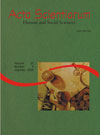<b>Brazilian textile industry under the impact of economic opening from 1992 to 1999</b> - DOI: 10.4025/actascihumansoc.v28i1.189
Abstract
This article presents the Brazilian textile trade balance, machinery and equipments importation as well as the domestic textile production as a result of economic opening and the effects on the employment according to the segments (coring/cleaning, spinning/weaving, knitting and finishing) and size (micro, small, medium and large industries). This work was based on the analyses of bibliographical documents from the Statistical Series of the Textile Productive Chains and Clothing of the Brazilian Association of Textile Industry and the Union of Textile Industry in São Paulo and from the Braz ilian Department of Labor and Job through the Annual Social Information Report – RAISTRAB and RAISETAB. The textile industry, in particular, reflected the changes imposed by the opening of Brazilian economy, increasing the imports, reducing the average age of the equipments, and, mainly, the number of employees in spite of the relative stability in the production volume. All the segments reduced the number of employees, except the finishing one, which increased the number of workplaces.Downloads
Download data is not yet available.
Published
2007-11-12
How to Cite
Massuda, E. M. (2007). <b>Brazilian textile industry under the impact of economic opening from 1992 to 1999</b> - DOI: 10.4025/actascihumansoc.v28i1.189. Acta Scientiarum. Human and Social Sciences, 28(1), 121-129. https://doi.org/10.4025/actascihumansoc.v28i1.189
Issue
Section
Social Sciences
DECLARATION OF ORIGINALITY AND COPYRIGHTS
I Declare that current article is original and has not been submitted for publication, in part or in whole, to any other national or international journal.
The copyrights belong exclusively to the authors. Published content is licensed under Creative Commons Attribution 4.0 (CC BY 4.0) guidelines, which allows sharing (copy and distribution of the material in any medium or format) and adaptation (remix, transform, and build upon the material) for any purpose, even commercially, under the terms of attribution.
Read this link for further information on how to use CC BY 4.0 properly.























